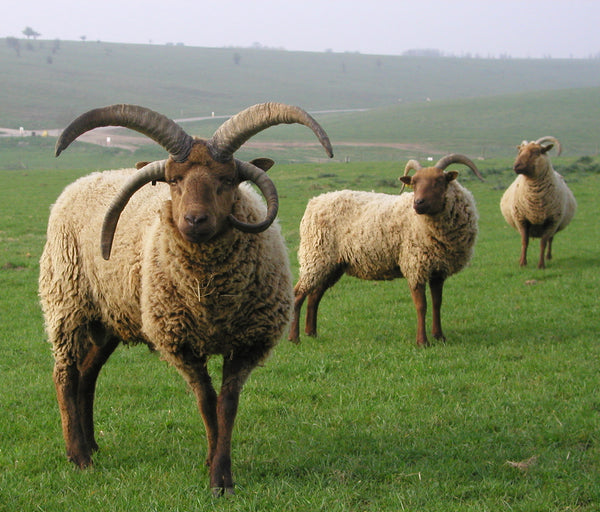Know Your Fiber: Manx Loaghtan
Posted on March 31 2019

Who has adorable horns (up to six!) and has made dramatic come-backs from the brink of extinction? Manx Loaghtan sheep from the Isle of Man, that’s who! These unique sheep came back from extinction, not once, not twice, but three times – and today are helping to influence a comeback of the native plants and animals on Jersey Island for good measure.
The Manx Loaghtan tale begins as most European sheep stories do, during the late Paleolithic and Bronze Age as agriculture developed and sheep domestication spread throughout Europe. People on what is now known as the Isle of Man began domesticating and raising sheep during this period for wool and meat. Isolated from the rest of the sheep population of Europe, it is likely that during this period of time the sheep on the Isle of Man began to develop some of the traits that are notable for the Manx breed, including frequently giving birth to twins and the ability to thrive by eating the scrubbiest of island plants.
When Vikings first arrived on the Isle of Man sometime around the year 800 they brought along their own short-tailed sheep, which interbred with the native Manx sheep. For hundreds of years, these sheep were the only breed of sheep on the Isle of Man. Although Manx sheep had a wide array of colored coats, it was the light brown colored coat that gained the most admiration and became most desirable. This color was known in Manx as Loaghtan, meaning mouse-colored.
The gene that produces the Loaghtan colored wool is recessive, and so this color was fairly rare. The wool was precious enough by the 1600s that it was singled out as an item of particular interest when the Earl of Derby in 1650 had a n entire suit made out of it, which presumably impressed his peers with its value and relative rarity. Mention of Loaghtan wool also began to show up in wills of the 1600s as well, being considered valuable enough to rate a special mention and to be bequeathed to selected heirs.
By the late 1700s, Manx Loaghtan wool was staring to really come into its own. Various books throughout Great Britain mentioned it on account of its lovely color. This natural color was so valued because it meant the wool could be woven into beautifully colored fabric without having to be dyed – which was, of course, a laborious process at the time. However, with the industrial revolution came industrial dyeing, which meant that dyed wool began to become cheaper and more available to the larger population. This meant that the Manx Loaghtan began to become less popular starting sometime in the mid-1800s. With this shift, Manx islanders began to import other breeds of sheep who had white coats - the ideal color of wool to be sold to factories for dyeing. The native Manx sheep, including the Loaghtan colored ones, began to decline.
By the late 1800s, the native Manx sheep were almost extinct. Robert Quirk, a farmer on the Isle of Man, had the only Manx Loaghtan flock left on the island. True to his surname, Quirk had a reputation as a rather eccentric person who ploughed his field with a horse and a cow and used an old top hat to hold the seeds of his turnip planting drill. While everyone else on the Isle of Man was modernizing their flocks with new breeds and using new farming techniques, Quirk was holding onto the old ways. That was a good thing for the Manx Loaghtan, and a good thing for John Caesar Bacon, who became known for bringing the breed out from under their first threat of extinction.
John Caesar Bacon was a wealthy heir to two large estates on the Isle of Man, the Seafield and Staward farms. He had an interest in pedigree livestock farming, focusing on cattle and sheep. Fascinated with the ideal of reviving the native Manx Loaghtan sheep, Bacon purchased his first Manx Loaghtan in the late 1800s from Robert Quirk’s flock. Bacon busily began to increase his flock size, touting the Manx Loaghtans’ benefits as beautiful multi-horned park sheep (ornamental sheep for large estates), as well as for their wool’s beauty and the tastiness of their meat. By 1904, he had the first major sale of his Manx Loaghtan flock, selling almost half of them to eager buyers.
John Caesar Bacon did much to promote the Manx Loaghtan during his lifetime, and to their great benefit. However, when he died in 1916, the breed once again began to decline. Bacon had enthusiastically promoted Manx Loaghtan, and it seemed that no one else could do it quite like him. By the late 1930s, the breed was once again almost extinct. At this point, another hobby farmer would once again rise to the occasion: Mark Collet, who loved Manx culture (and by extension, the Manx Loaghtan), believing that his family originated from the Isle of Man.
Unfortunately, Mark Collet’s revival of the Manx Loaghtan was short-lived. By the early 1950s, there were only three small flocks left on the Isle of Man. Conservationists stepped in just in time when the Manx Museum and National Trust purchased a flock of Manx Loaghtan for preservation. Slowly, the breed’s popularity began to rise again, and farms in the area began to raise Manx Loaghtan again.
The population of this heritage breed is still not large – there are only around 1,500 registered ewes in existence. However, interest in the Manx Loaghtan’s wool and meat, not to mentioned its heritage, have meant their numbers have continued to grow, albeit slowly, over the last several decades. As scientists have continued to study sheep on the Isle of Man, they have also discovered something very interesting – it appears that sheep fill an essential ecological niche not only on the Isle of Man, but also on the Channel Islands. Which brings us to Jersey Island in the English Channel, and their population of Manx Loaghtans.
Jersey Island was once legendary for their knitted goods during the 1500s-1600s. During that time, their knitters were so prolific that the word jersey came to be used interchangeably with the word knitting. Knitting was so profitable (and apparently so distracting) for the islanders, that laws were put in place to punish people caught knitting instead of working in the fields during harvest season. However, with the start of the industrial revolution, knitting soon became far less profitable. As the hand-knitting industry on Jersey waned so did the popularity of raising sheep, and soon the native Jersey Island sheep became extinct.
Once the native Jersey sheep became extinct, the island’s eco-system underwent drastic changes. There was a significant loss of bio-diversity over the years, culminating in the northern part of the island’s open grasslands and heath being covered in bracken, which created a thick layer of material through which few other plants could grow. This led to a decrease in native plant and animal populations, including the Red Billed Chough, a bird that ended up completely disappearing from Jersey Island.
As studies were made, it became clear that sheep had filled an essential ecological niche on Jersey Island, and in 2009 it was decided that something must be done. Looking for sheep that were the most similar to the extinct Jersey sheep, Jersey Island settled on the Manx Loaghtan, bringing in twenty-two of them to the northern part of the island. The change has been remarkable. The grazing sheep control the bracken by eating and trampling it down, which makes room for native plant species. This has led to an increase in bugs and worms in the soil, which has in turn led to a return of the Red Billed Chough and an increase in other native animal populations. Truly a woolly success story for Jersey Island, brought in on the hooves of the Manx Loaghtan.
So, what makes the wool of the Manx Loaghtan amazing? Well, for starters its color. As previously mentioned, Loaghtan means mouse-colored in Manx, but this particular color is more commonly known in the spinning world as moorit – a particular shade of light brown that is produced by only some breeds of sheep which include the Manx Loaghtan, the Shetland, and the Castlemilk Moorit. It has a staple length of around 3 inches, and a wonderful crimp. A micron count of 29-31 means that it is best used for outwear; while it is not super soft like Merino and other fine wools, it is not overly scratchy, either.
Looking for some Manx Loaghtan to try out yourself? It is one of the single-breed wools that we carry for spinners and felters. Try this heritage wool, and see what all the buzz is about!
Photo attribution: EFearn [CC BY-SA 4.0 (https://creativecommons.org/licenses/by-sa/4.0)]

Follow US